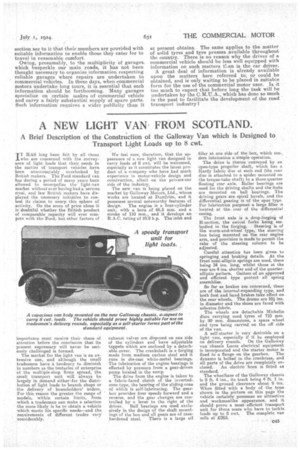A NEW LIGHT VAN , FROM SCOTLAND.
Page 33

If you've noticed an error in this article please click here to report it so we can fix it.
A Brief Description of the Construction of the Galloway Van which is Designed to Transport Light Loads up to 8 cwt.
IT HAS long been felt by all those who are concerned with the conveyance of light • loads that their needs in the matter of transport vehicles have been unaccountably overlooked by British makers. The Ford standard van has during a period of many years been allowed to monopolize the light-van market without ever having had a. serious rival, and few British makers have displayed the necessary initiative to contest its claims to usurp this sphere of activity. On the score of price alone it is doubtful whether the British product of comparable capacity will ever compete with the Ford. but other factors or
importance must receive their share of attention before the conclusion that its present supremacy will never be seriously challenged is formed.
The market for the light van is an extensive one, and although the small tradesmen have a tendency to diminish in numbers as the tentacles of enterprise of the multiple-shop firms spread, the Small transport unit will always be largely in demand either-for the distribution of light loads to branch shops or the delivery of householders' Orders. For this reason the greater the range of models, within certain limits, from which a. tradesman can make a selection the more likely is he to obtain a, vehicle .which meets his specific needs—and the requirements of different trades vary considerably.
We feel sure, therefore, that the appearance of a new light van designed to carry loads of 8 cwt. will be welcomed, especially as it constitutes the latest product of a company who have had much experience in motor-vehicle design and construction, albeit on the private-car side of the industry. The new van is being placed on the market by Galloway Motors, Ltd., whose works are located at Dumfries, and it possesses several noteworthy features of
design. The engine is a four-cylinder unit, with a bore of 66.5 mm. and a stroke of 110 ram., and it develops an R.A.C. rating of 10.9 b.p. The inlet and exhaust valves are disposed on one side of the cylinders and have adjustable tappets which are enclosed by a detachable cover. The crankshaft is a forging made from medium carbon steel and it runs in die-cast white-metal bearings. The lubrication of the engine bearings is effected by pressure from a gear-driven pump located in the sump. The drive from the engine is taken to a fabric-faced clutch of the inverted-. cone type, the bearing of the sliding cone of which is self-lubricating. The gearbox provides four speeds forward and a reverse, and the gear changes are controlled by a lever to the right of the driver. Ball bearings are used exclusively in the design of the shaft mountings of the box and all gears are of case
hardened steel. There is a large oil filler at one side of the box, which ren ders lubrication a simple operation. .
The drive is thence conveyed by air open-type propeller shaft, which has a Hardy fabric disc at each end (the rear disc is attached to a spider mounted on the torque-tube shaft) to a three-quarter floating rear axle. Roller bearings are used for the driving shafts and the hubs are mounted on ball bearings. The driving gears are spiral bevels, and the differential gearing is of the spur type. For lubrication purposes a large filler is located at the rear of the differential casing. . _ The front axle is a drop-forging of H-section, the swivel forks -being embodied in the forging. Steering is of the worm-and-wheel type, the steeririg box being mounted on the rear engine arm, and provision is made to permit the rake of the steering column to be adjusted.
Careful attention has been given to springing and braking details. At the front semi-elliptic springs are used, these being 34 ins, long, whilst those at the rear are 4 ins, shorter and of the quarterelliptic pattern. Gaiters of an approved and efficient type protect all spring assemblies.
So far as brakes are concerned, these are of the internal-expanding type, and both foot and hand brakes take effect on the rear wheels. The drums are 10f ins. in diameter and the shoes are faced with asbestos fabric.
The wheels are detachable Michelin discs carrying cord tyres of 710 mm. by 90 mm, dimensions, a spare wheel and tyre being carried on the off side of the van.
A self-starter is very desirable on a light van, especially if it be employed on delivery rounds. On the Galloway van 'chassis Lucas electrical equipment is incorporated and the starter motor is fixed to a flange on the gearbox. The dynamo is bolted to the crankcase and all parts of the drive are completely en closed. An electric horn is fitted as standard.
The wheelbase of the Galloway chassis is 9 ft. 4 ins., its track being 4 ft. 1 in. and the ground clearance about 9 ins. When fitted with a body of the type shown in the picture on this page the vehicle certainly possesses an attractive and workmanlike appearance, and it should prove a most efficient transport unit for those users who have to tackle loads up to 8 cwt. The complete van sells at £265.














































